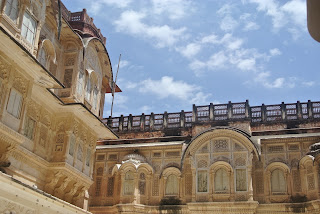When we arrive at our hotel in Jodhpur, I climb up to the roof in the hope of getting a glimpse of the fort. I climb the steps and turn a circle, not seeing it until suddenly its there, too big to take in all at once. Most of the hotels and restaurants we had passed claimed to have 'Excellent Fort Views' and I realise that every building in Jodhpur must have excellent fort views - it is impossible to miss.
Visiting Mehrangarh is a lot like visiting a National Trust building and very unlike visiting anywhere in India. There is a coffee shop, a gift shop and a book shop; the audio guide is excellent and included in the ticket price; signs are spelt correctly and point to where they say they point to and everything is labelled.
The audio guide has 35 different parts, including the origins of the fort to its function today. When Rao Jodah (hence the name Jodhpur) began building in 1459, he displaced the hill's only human occupant, a hermit called Cheeria Nathji, Lord of the Birds, who cursed Rao Jodha, dooming Mehrangarah to enternal drought, which was kind of a problem in the desert. In order to appease Cheeria, Jodha built him a house and temple wihin the fort. However, the gods still needed a sacrifice and a man voulenteered to be burried alive in the walls of the castle with the promise that his family would be well looked after. His descendants are some of the few people who still live in the fort today, and a small plaque marks the spot on the wall in which he was burried.
Mehrangarh has never been sucessfully invaded. Its defences include 36m high walls, naturally heightened by the huge outcrop on which it sits, and a gate reached via a sharp right-angled turn and coveres in even sharper spikes, both designed to hinder the charge of elephants used by invading armies. On the wall just inside of the gate are the hand prints of Maharaja Man Singh's widows, placed there in 1843 as the left the palace to commit mass sati, sacraficing themselves on their husband's funeral pyre in emmulation of the god Shiva's wife. This practice is no longer legal, but still takes place and is some times forced.
The Royal palace is no longer inhabited by the present Maharaja, but set up as a museum on his return from Eton and Oxford (possibly explaining the National Trust style organisation and his perfect English accent on the audio tape). Although the Maharaja holds no offical power or title, he is still an important public figure and extremely wealthy.
Above: The Women's Quarters, where they could look out on the courtyard below without being seen themselves.
Above: The Moti Mahal, used for councils of state
From the fort we get amazing views of 'The Blue City'. I have heard two stories as to why so many of the houses in Jodhpur are painted blue. The first claim is that, because blue is the color of Brahmins, the highest caste in Hinduism, invading armys would not attack houses where painted blue - a trick which didn't take long to catch on. The second simply claims that blue is cooling in the summer, and deters insects.






No comments:
Post a Comment